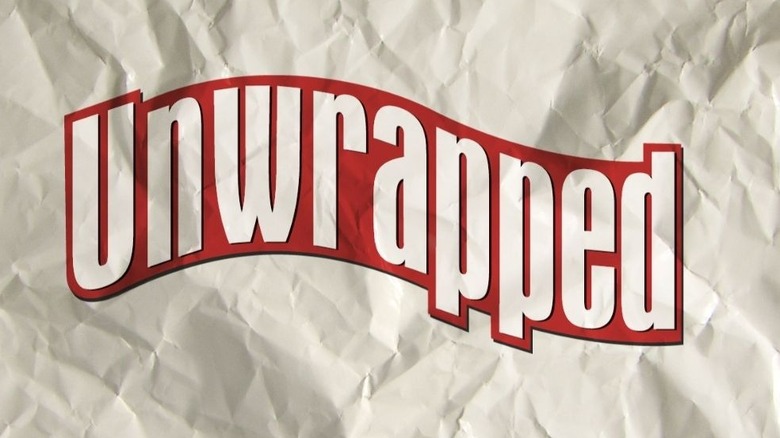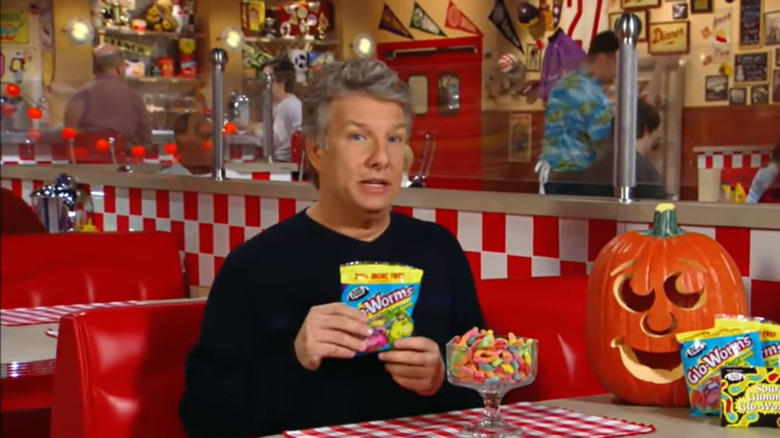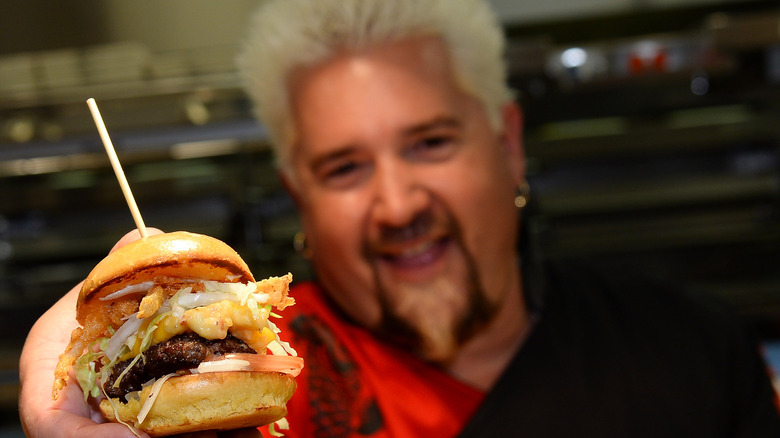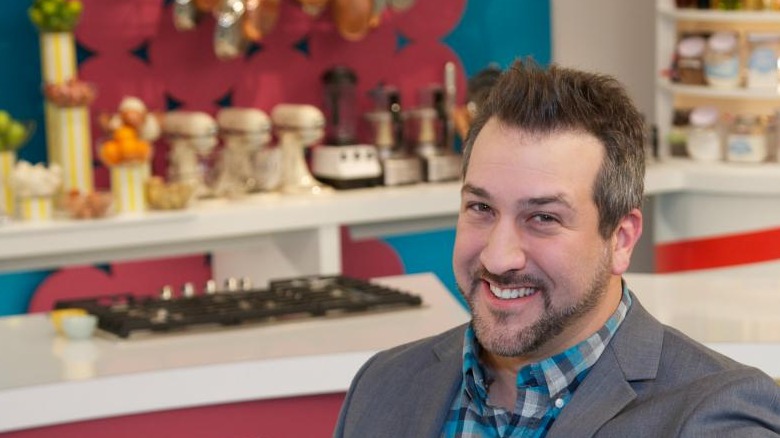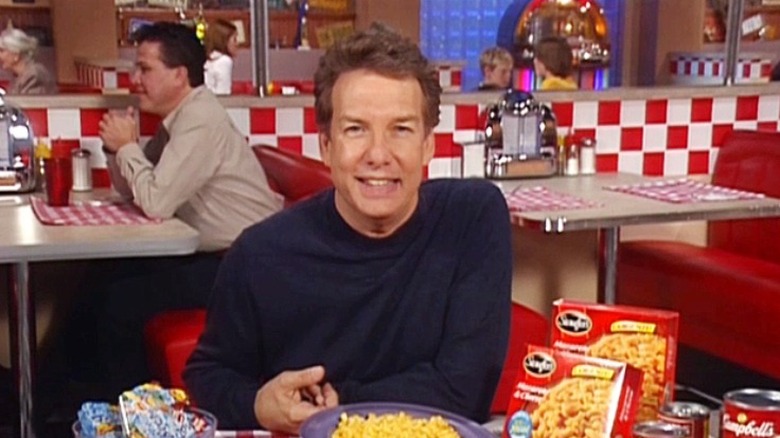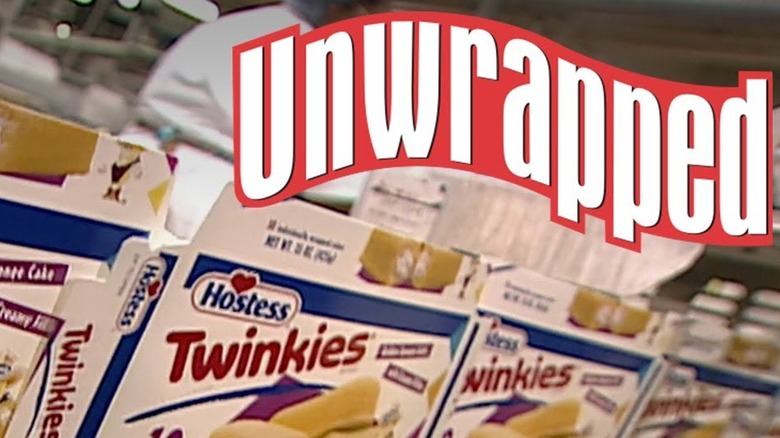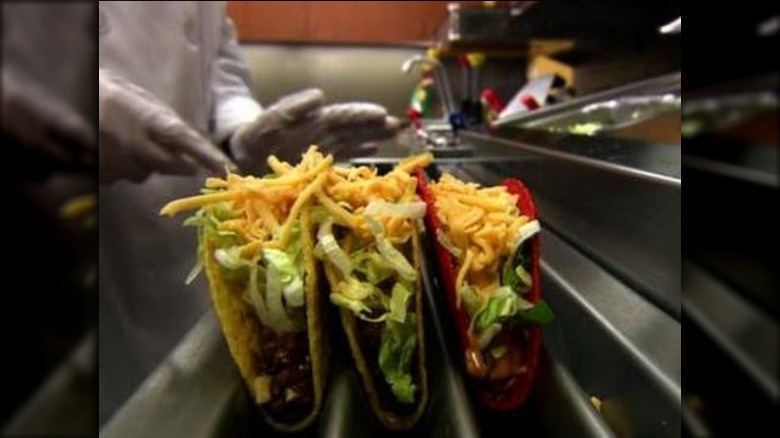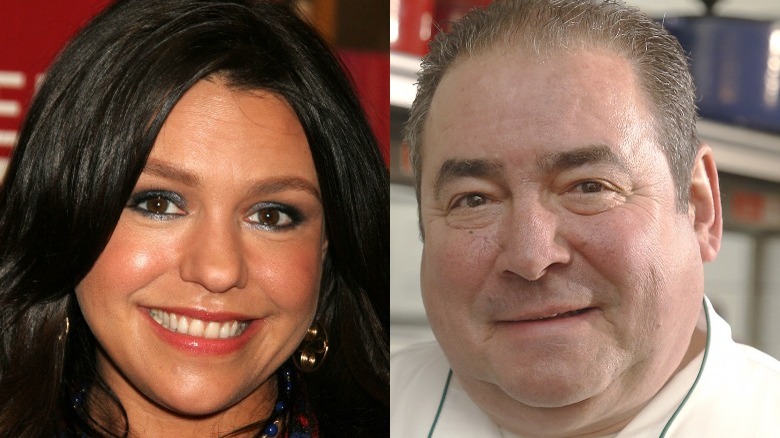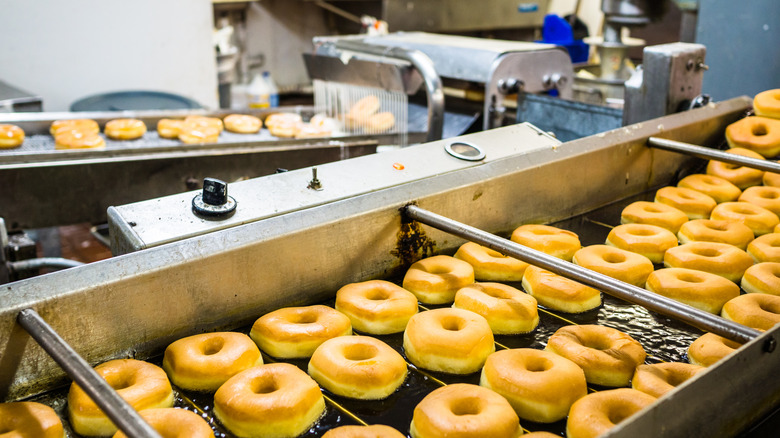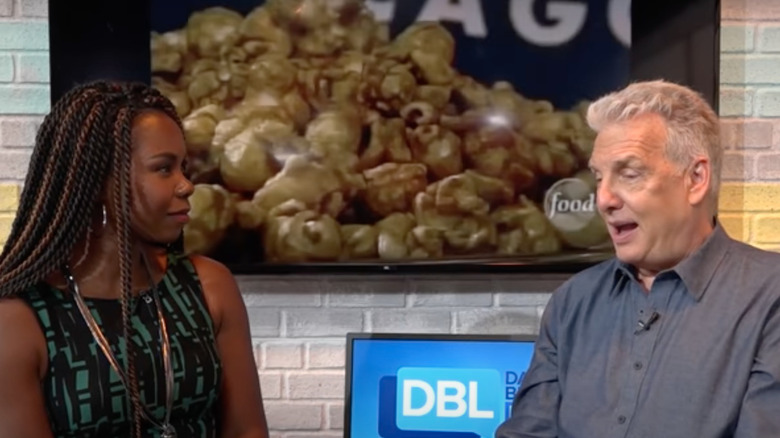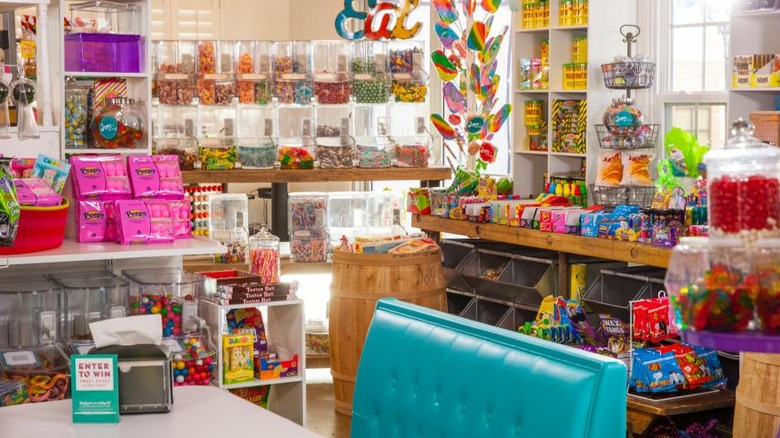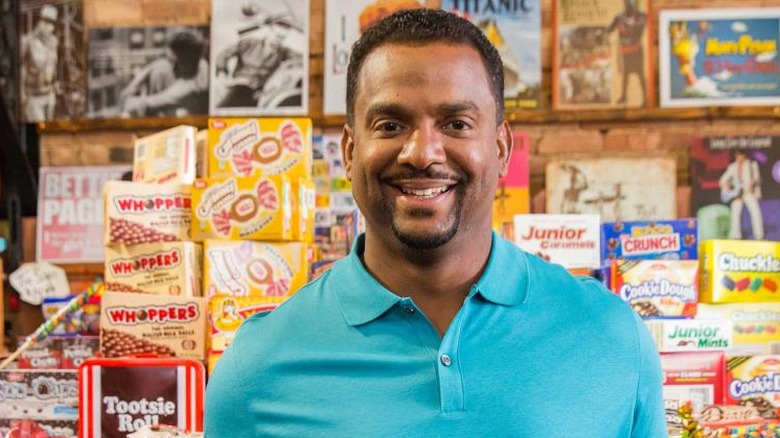The Untold Truth Of Unwrapped
These days, our eyes and ears are never short of new ways to watch people do that old favorite human necessity. Cooking shows are everywhere, from streaming services to television channels, but in the earliest parts of this millennium, the programming was not always so inventive. Common shows focused on bringing recipe instructions to the home cooks who cared enough to learn, but often left out the food lovers who wanted to know more about the ways their favorite grub was made. Americans were hungry for food programming that reflected their interests, and it was into this scene that "Unwrapped" was served.
For a decade, "Unwrapped" took some of the culture's most common cuisines and made them interesting. By bringing the casual viewer on a journey through how their favorite foods, snacks, and beverages are made, "Unwrapped" drew back the curtain on the world of commercial foods. You may remember the show for teaching you how they form your favorite candies or just what goes into making that fast food item you crave late at night. Whatever your reason was for watching "Unwrapped," the show never failed to stir a rumble in your stomach or make the mouth water. Twenty years later, here are some untold truths about the wistful show that had us all reaching into the cupboards.
Marc Summers never actually visited the food factories on the show
Throughout the 22 season run of "Unwrapped," host Marc Summers took viewers on a journey through food factories all across America. Who can forget watching Goldfish being baked by the millions at the Pepperidge Farm facility in Denver, Pennsylvania, or seeing the miles of "crispity, crunchity" Butterfingers that rolled down the lines of the Nestle factory in Franklin, Illinois?
Yet, despite taking food lovers all across the country, "Unwrapped" host Marc Summer's told Erica Cobb of the Daily Blast that he never actually visited any of these amazing locales or factories. Instead, "Unwrapped" was produced using "wrap around" shots of factory floors and employees, then combined with shots of Summers at one of several set locations across the country.
According to reports from food blog Wide Open Eats, the retro diners where Summers introduced us to the delicious foods of focus for each episode were actually production sites based in Orlando, Pueblo, Colorado, and Hershey, Pennsylvania. However, Summers did often shoot segments at local establishments that were featured on the show, such as the Jefferson Diner in New Jersey.
Unwrapped was the starter dough for several spin-offs that would be baked up by Food Network
After an incredible run that began in 2001, "Unwrapped" was pulled from the air in 2011. As Allen Salkin details in his tell-all book, "From Scratch: The Uncensored History of the Food Network" things were changing at the show's home network. "Unwrapped" was still a beloved show, but infotainment programs were giving up ground in the ratings. Instead, Food Network fans were developing a continued appetite for competition shows like "Iron Chef" and "Chopped," along with travel programming such as "Diners, Drive-Ins, and Dives."
Still, like the scent of a favorite comfort food, "Unwrapped" lingered. Beginning in 2004, Summers leaned into his previous experience as a game show host to help cook up "Trivia Unwrapped," the first spin-off of the franchise. The show pit contestants against each other in a battle of food fact knowledge, using the same sorts of pop-culture cuisines that made the original so popular.
As reported in Complex, "Trivia Unwrapped" ran from 2004 to 2005 before being pulled off the air. Fortunately for viewers, "Unwrapped" would stay fresh for several more years before Food Network moved in a different direction.
An Unwrapped spin-off featured a former boy band member
"Unwrapped" has always been about nostalgia. So naturally, when the show reemerged for its third iteration, it would do so with another icon of the early millennium. Enter former NSYNC member Joey Fatone, host of "Rewrapped."
In 2014, the Associated Press reported that the top minds at Food Network had an idea to repurpose old footage from "Unwrapped" production into something new. Marc Summers, hot off of a successful run producing "Restaurant: Impossible," helped develop an "Unwrapped" spin-off concept that would tap into the show's popularity while helping it satisfy the taste of the times. Those ingredients combined led to the show "Rewrapped."
Judged by Summers and hosted by Fatone, "Rewrapped" stepped into the cooking challenge sphere while also pulling deeply from the well of "Unwrapped" history. The goal was for contestant cooks to take products from "Unwrapped's" top episodes (like Twinkies, Hostess cupcakes, and Goldfish) and recreate their commercial flavors and textures while on the clock. Despite the enduring popularity of its predecessor, "Rewrapped" only made it two seasons as well before going cold
How Marc Summers landed the gig as host of Unwrapped
Marc Summers's long history with food started well before "Unwrapped," but not in the way you might expect. Recently, Summers was featured on the Youtube show "Hosts at Home," where he disclosed that prior to TV, he was in the smoked salmon business.
However, Summers had a hunger for show business. As a magician and comedian, he dreamed of taking over the "Late Show" from Johnny Carson. However, instead of landing on adult talk shows, he ended up working for a burgeoning kid's network known as Nickelodeon where he was the host of the game show "Double Dare." The choice to walk away from salmon and towards green slime turned Summers into a familiar face with the same millennials who grew into the foodies that supported Food Network's emergence as a hub of grub culture.
Allen Salkin writes that after "Double Dare" ended, a network of Nickelodeon-turned-Food Network producers brought Summers into the fold. They started him off with a show called "It's a Surprise!" which took Marc around the country throwing surprise parties for regular people. As Summers himself joked, "the surprise was that nobody was watching it."
The real surprise might be that as "It's a Surprise!" was bombing, another hit program was developing in its place. "Unwrapped" was born as a second chance for Summers, but the success of the new show was yet to be proved.
Prior to Unwrapped, Food Network was running another show which nearly took Unwrapped's place
The difference between the two shows was pop-culture and nostalgia. At the same time that "Unwrapped" was beginning, another show was traveling around the country examining how foods were made. This show was called "Food Finds." As Salkin writes, during the time that "Unwrapped" was in development, "Food Finds" was Food Network's on-the-road show for cuisine discovery. Host Sarah Pinckney would journey through the country, uncovering old-fashioned favorites like kettle chips, smokehouse sausages, and jams.
During this time, budgeting increased around the Network and producers were choosing where to spend it all. Eventually, the question was put between boosting "Food Finds" or shifting to a show that would center on the pop culture of the current food movement. As marketing expert Adam Rockmore put it, "You can learn about Twinkies and about Junior Mints, or you can learn about pretzels from Amish country?"
The history of "Unwrapped" proves which dishes the American audience preferred. While "Food Finds" did run for over 140 episodes, it eventually grew stale in 2006. The nostalgia-packaged charm of "Unwrapped" would last for another four years (and then some).
Unwrapped was one of Food Network's longest running shows, but it wasn't always a hit
Despite eclipsing other Food Network shows in run-time and popularity, "Unwrapped's" success was not pre-baked. Marc Summers credits the show's success to a simple time slot switch from 10:30 pm to 9:00 pm. The change in air time exploded the audience and the result is the popular show we've come to love.
In an interview with Eater, Summers opened up about the first run of his hit show. As it turns out, the program almost wrapped up before it could gain steam. When the initial episodes premiered, garnering a regular audience was the biggest challenge. Food Network had decided that pop-culture television was the future, but where was the population to support it?
Initially, "Unwrapped" aired at 10:30 pm on Monday evenings. It was an uphill battle to gain viewership and the network brass told Summers that if the show couldn't take off then it would be trashed. Luckily for fans of commercial foods, there was a switch. "Unwrapped" moved to the 9:00 pm slot on Mondays, and viewers began rolling in like Pop-Tarts down a conveyor belt.
Just as "Unwrapped" once taught us that Taco Bell grills burritos for exactly 27 seconds, fast food or food TV, all comes down to timing.
Unwrapped was part of Food Network's strategy to diversify from cooking shows
In the early 2000s, Food Network was all about chef-driven content. Yet, back then it was served up in a much different presentation than what we know today. It was the time of recipe-focused cooking shows. Chefs like Rachel Ray and Emeril Lagasse ruled the airwaves, walking the home cook through the steps of making delectable dishes they normally wouldn't consider trying alone. However, as Thrillist noted on the 20th anniversary of "Unwrapped," if you weren't cooking during that period, did you really have a reason to be watching the Food Network?
Allen Salkin writes that during the early aughts of the 2000s, Food Network was eager to bring in viewers who had more of an interest in food than just cooking it. "Unwrapped" was the perfect addition to that strategy. One-part information, one-part mouth-watering shots of your favorite candy, and one-part travel show; "Unwrapped" had a recipe for success. Although the show took time to generate a buzz, audiences were hooked on learning facts about their favorite snacks.
For example, did you know that Cheez-Its uses nearly 30 million pounds of cheddar a year? Or that a KFC chicken is tossed in batter exactly seven times, every time? These are the hard-hitting food facts that "Unwrapped" has been delightfully delivering ever since the Food Network pivoted to reach food lovers of all kinds.
Unwrapped focused on the smaller brands in addition to the international brands
Some reviewers of "Unwrapped" have targeted the show as a thin-veil for consumer food marketing, but in reality, the show had a bigger focus than that. Sure, viewers were hooked by learning about the particular process of crafting Coca-Cola, or finally finding out why Cheetos are so crave-worthy. However, a lot of the show's original charm comes from the viewer's introduction to hyper-local and regional foods as well.
Take the exposure of Ocean City, Maryland-based donut shop Fractured Prune. The hot, made-to-order treats could once only be found at three locations along the Atlantic Coast. Now, the shop is nationwide, with locations as far as Tempe, Arizona. It may be debatable whether a direct connection can be drawn between Fractured Prune's highlight on "Unwrapped" and the business's growing success. However, as another Food Network darling "Diners, Drive-Ins and Dives" suggests, TV popularity can really help a local restaurant thrive.
It's undeniable that much of "Unwrapped's" esteem comes from the way it led us through the journey of how favorite snacks (and yes, junk food) make it from the factory to our mouths. The untold truth of "Unwrapped" is that for many, the show was much more: "Unwrapped" is an economic boost, an exposition into the skilled workers who make a food factory run, and a vindication that our favorite local fare is more universal than we ever knew.
There's one Unwrapped food that is burned into Marc Summers memory
Marc Summers claims not to have a favorite episode of "Unwrapped," which is totally believable when you consider just how many episodes of the show he filmed. However, there is one "Unwrapped" feature that's remained with the host, even after all this time. In conversation with the Daily Blast, Summers says that it was a piece of chocolate that has remained a keepsake memory of his time on "Unwrapped." The ominous candy in question was called a Cowgirl Chocolate, a confection known for being as full and vivacious as its namesake.
Summers told Erica Cobb of the Daily Blast that while filming what would be the first episode of "Unwrapped" Season 2, a producer warned him to avoid eating the chocolate. Rumour was that it ranked high on the Scoville scale of spiciness, thanks to what Summers can now only guess was the inclusion of a ghost pepper. Naturally, Summers didn't take the advice. The result was a burning mouth and a delay in production.
The real untold truth of "Unwrapped"? Apparently, not every treat is as sweet as it looks.
Unwrapped was brought back in 2015
For years, "Unwrapped" was the Food Network's longest-running show. Despite that lofty status eventually being claimed by "Diners, Drive-Ins, and Dives,"
"Unwrapped" has remained a stalwart of food infotainment in hearts and bellies for two decades. Despite new twists on an old recipe with its various spin-offs, the original style of the program couldn't be replaced. In 2015, Food Network tossed "Unwrapped" back in the fryer, and "Unwrapped 2.0" emerged hot and ready.
In many ways, "Unwrapped 2.0" tried to reimagine the aspects that made the original popular. Host segments were shot on a nostalgic set, another 90s TV icon was brought in to guide viewers (more on that in a second), and the focus remained on popular snacks accessible to Americans. Still, for many, the "Unwrapped 2.0" reboot was a new show in its own right. Take the set for example ... Mountains of candy were brought in to create the filming stage known as Sugar Drive, while other host segments were shot at the popular candy franchise RocketFizz. To fit with the times, "Unwrapped 2.0" was even given a snappy hashtag: "Get in on the #Snacktion."
What remained common between the two shows was an endearing love for American pop-culture foods and how they're made.
Unwrapped 2.0's reboot featured another 90s TV icon as host
Although "Unwrapped 2.0" looked a lot like the original, the flavor of the show changed when "Fresh Prince of Bel-Air" star Alfonso Ribiero joined Food Network as the new host. Just as he had with the forever-memorable Carlton, Alfonso brought his own flair to this new version of "Unwrapped." For three seasons, viewers were given a comforting presence a la Marc Summers, while learning about the ins and outs of food production from Ribiero's unique voice, perspective, and humor.
There's been some rumored beef around how Summers feels about not resuming host duties of "Unwrapped 2.0." Regardless, Ribiero carried on the family-friendly tradition with class and wit. When interviewed by the Milwaukee Journal Sentinal about touring for "Unwrapped," Ribiero mentioned that the journey across America's foodscape was a family affair. Alfonso's wife and son joined him as he explored the production lines and people who make America's favorite foods. Alfonso's favorite? The Carolina Honeybun.
Perhaps the biggest untold truth Ribiero has shared about "Unwrapped" is that most of the foods we see on the show come from similar ingredients made with different recipes. When it comes to "Unwrapped 2.0," viewers can be glad that despite new ingredients being used to remake the program, the end result was a loving recreation of a tried and true comfort show.
